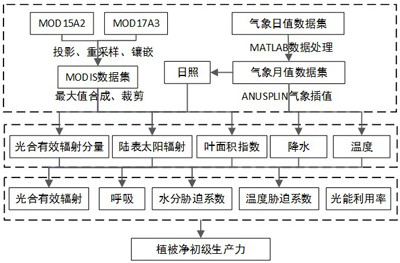NPP calculation method suitable for alpine grassland ecosystem
A calculation method and ecosystem technology, applied in the direction of calculation, computer-aided design, data processing applications, etc., can solve problems such as the inability to explain the maximum growth rate, and achieve the effect of clear model structure and reliable calculation results
- Summary
- Abstract
- Description
- Claims
- Application Information
AI Technical Summary
Problems solved by technology
Method used
Image
Examples
Embodiment Construction
[0051] Considering the time and space scales of the study area comprehensively, select appropriate remote sensing images and weather station data. The remote sensing image is projected, resampled, time series reconstructed and combined with the maximum value to convert it into a monthly dataset. Weather station data are spatially interpolated and resampled to monthly datasets of the same resolution. The processed meteorological data and remote sensing data are used to calculate land surface solar radiation, photosynthetically active radiation component, temperature stress, water stress, light energy utilization rate and autotrophic respiration, and then couple each sub-model together to solve the final NPP.
[0052] Sanjiangyuan is located in the south of Qinghai Province, in the hinterland of the Qinghai-Tibet Plateau, with an average altitude of more than 4,000 meters. It is the birthplace of the Yangtze River, the Yellow River, and the Lancang River. It has an important fun...
PUM
 Login to View More
Login to View More Abstract
Description
Claims
Application Information
 Login to View More
Login to View More - R&D
- Intellectual Property
- Life Sciences
- Materials
- Tech Scout
- Unparalleled Data Quality
- Higher Quality Content
- 60% Fewer Hallucinations
Browse by: Latest US Patents, China's latest patents, Technical Efficacy Thesaurus, Application Domain, Technology Topic, Popular Technical Reports.
© 2025 PatSnap. All rights reserved.Legal|Privacy policy|Modern Slavery Act Transparency Statement|Sitemap|About US| Contact US: help@patsnap.com



